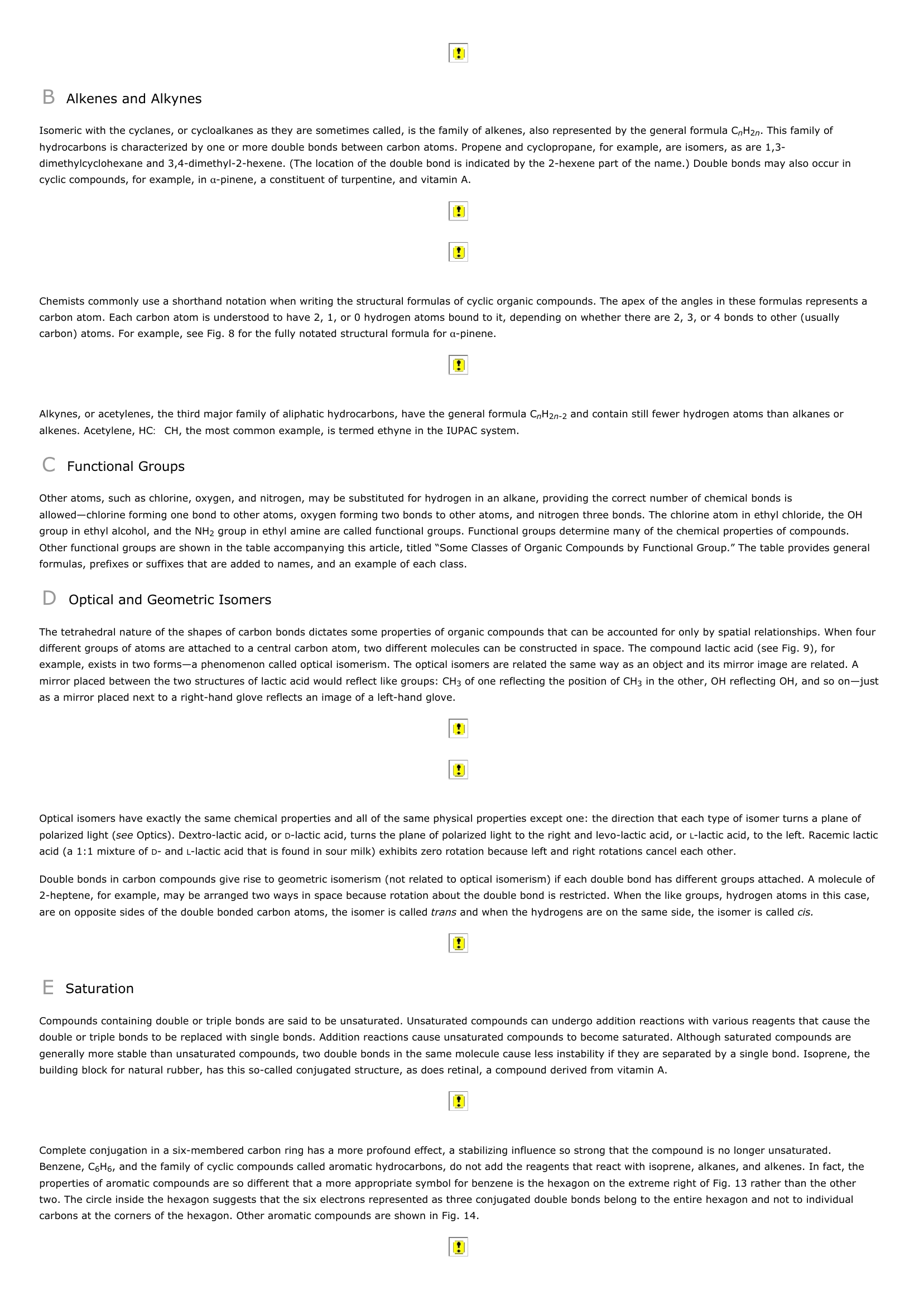Organic Chemistry - chemistry.
Publié le 11/05/2013

Extrait du document
«
B Alkenes and Alkynes
Isomeric with the cyclanes, or cycloalkanes as they are sometimes called, is the family of alkenes, also represented by the general formula C nH2n.
This family of hydrocarbons is characterized by one or more double bonds between carbon atoms.
Propene and cyclopropane, for example, are isomers, as are 1,3-dimethylcyclohexane and 3,4-dimethyl-2-hexene.
(The location of the double bond is indicated by the 2-hexene part of the name.) Double bonds may also occur incyclic compounds, for example, in α-pinene, a constituent of turpentine, and vitamin A.
Chemists commonly use a shorthand notation when writing the structural formulas of cyclic organic compounds.
The apex of the angles in these formulas represents acarbon atom.
Each carbon atom is understood to have 2, 1, or 0 hydrogen atoms bound to it, depending on whether there are 2, 3, or 4 bonds to other (usuallycarbon) atoms.
For example, see Fig.
8 for the fully notated structural formula for α-pinene.
Alkynes, or acetylenes, the third major family of aliphatic hydrocarbons, have the general formula C nH2n-2 and contain still fewer hydrogen atoms than alkanes or alkenes.
Acetylene, HC :CH, the most common example, is termed ethyne in the IUPAC system.
C Functional Groups
Other atoms, such as chlorine, oxygen, and nitrogen, may be substituted for hydrogen in an alkane, providing the correct number of chemical bonds isallowed—chlorine forming one bond to other atoms, oxygen forming two bonds to other atoms, and nitrogen three bonds.
The chlorine atom in ethyl chloride, the OHgroup in ethyl alcohol, and the NH 2 group in ethyl amine are called functional groups.
Functional groups determine many of the chemical properties of compounds. Other functional groups are shown in the table accompanying this article, titled “Some Classes of Organic Compounds by Functional Group.” The table provides generalformulas, prefixes or suffixes that are added to names, and an example of each class.
D Optical and Geometric Isomers
The tetrahedral nature of the shapes of carbon bonds dictates some properties of organic compounds that can be accounted for only by spatial relationships.
When fourdifferent groups of atoms are attached to a central carbon atom, two different molecules can be constructed in space.
The compound lactic acid (see Fig.
9), forexample, exists in two forms—a phenomenon called optical isomerism.
The optical isomers are related the same way as an object and its mirror image are related.
Amirror placed between the two structures of lactic acid would reflect like groups: CH 3 of one reflecting the position of CH 3 in the other, OH reflecting OH, and so on—just as a mirror placed next to a right-hand glove reflects an image of a left-hand glove.
Optical isomers have exactly the same chemical properties and all of the same physical properties except one: the direction that each type of isomer turns a plane ofpolarized light ( see Optics).
Dextro-lactic acid, or D-lactic acid, turns the plane of polarized light to the right and levo-lactic acid, or L-lactic acid, to the left.
Racemic lactic acid (a 1:1 mixture of D- and L-lactic acid that is found in sour milk) exhibits zero rotation because left and right rotations cancel each other.
Double bonds in carbon compounds give rise to geometric isomerism (not related to optical isomerism) if each double bond has different groups attached.
A molecule of2-heptene, for example, may be arranged two ways in space because rotation about the double bond is restricted.
When the like groups, hydrogen atoms in this case,are on opposite sides of the double bonded carbon atoms, the isomer is called trans and when the hydrogens are on the same side, the isomer is called cis.
E Saturation
Compounds containing double or triple bonds are said to be unsaturated.
Unsaturated compounds can undergo addition reactions with various reagents that cause thedouble or triple bonds to be replaced with single bonds.
Addition reactions cause unsaturated compounds to become saturated.
Although saturated compounds aregenerally more stable than unsaturated compounds, two double bonds in the same molecule cause less instability if they are separated by a single bond.
Isoprene, thebuilding block for natural rubber, has this so-called conjugated structure, as does retinal, a compound derived from vitamin A.
Complete conjugation in a six-membered carbon ring has a more profound effect, a stabilizing influence so strong that the compound is no longer unsaturated.Benzene, C 6H6, and the family of cyclic compounds called aromatic hydrocarbons, do not add the reagents that react with isoprene, alkanes, and alkenes.
In fact, the properties of aromatic compounds are so different that a more appropriate symbol for benzene is the hexagon on the extreme right of Fig.
13 rather than the othertwo.
The circle inside the hexagon suggests that the six electrons represented as three conjugated double bonds belong to the entire hexagon and not to individualcarbons at the corners of the hexagon.
Other aromatic compounds are shown in Fig.
14..
»
↓↓↓ APERÇU DU DOCUMENT ↓↓↓
Liens utiles
- « Life is a self-replicating, evoluing system based on organic chemistry » Qu’est ce qui est vivant ?
- Technetium - chemistry.
- Tellurium - chemistry.
- Terbium - chemistry.
- Thallium - chemistry.










